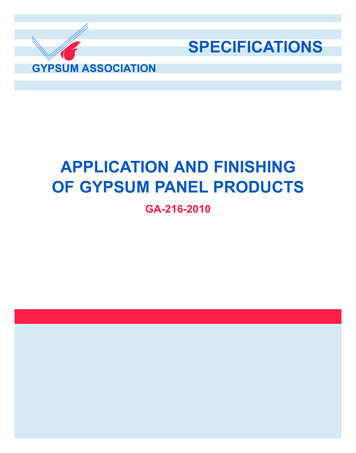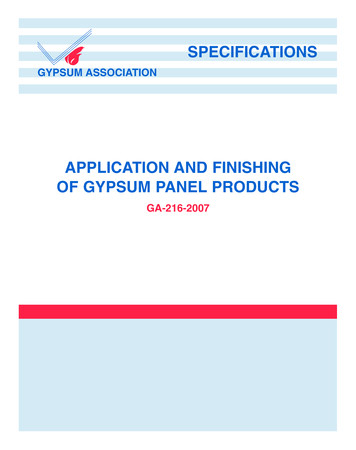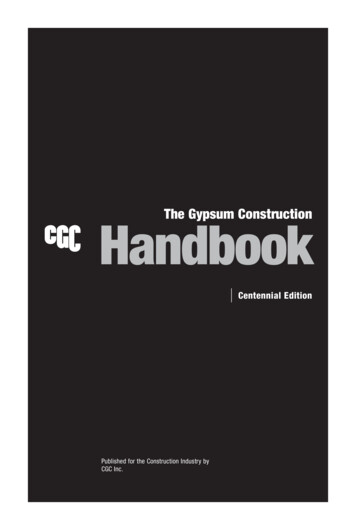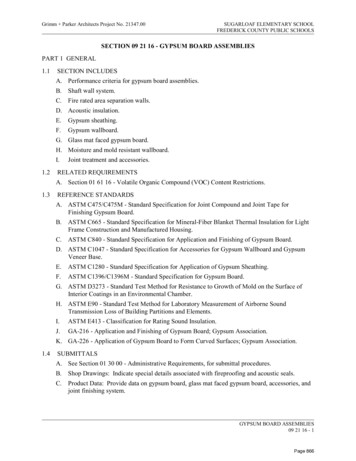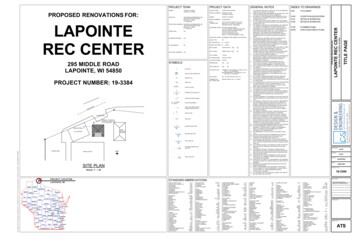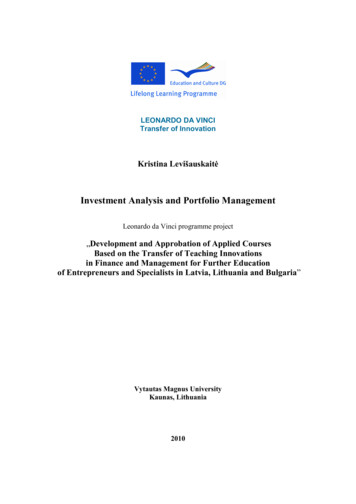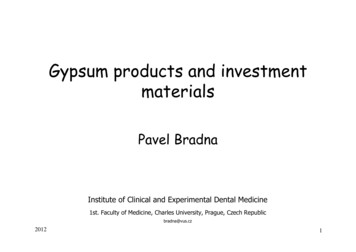
Transcription
Gypsum products and investmentmaterialsPavel BradnaInstitute of Clinical and Experimental Dental Medicine1st. Faculty of Medicine, Charles University, Prague, Czech Republicbradna@vus.cz20121
Gypsum productsIndications: models, casts, diesPreparation:Thermal decomposition (dehydratation, calcination)of natural or artificial CaSO4 . 2H2O (gypsum)110-130oCCaSO4 . 2H2OCalcium sulfate dihydratemonoclinic110-130oC2012 CaSO4 . 0.5H2O 1.5H2OCalcium sulfate β-hemihydrate(orthorhombic) impurities, anhydriteplaster (β-hemihydrate) (CaSO4.0.5H2O)130-200oCγ-anhydrite (soluble CaSO4)200-1000oCβ-anhydrite (insoluble CaSO4)2
Properties and types of gypsum productsdepend on dehydration conditionsDecomposition in an open reactor: β-hemihydrate(Plaster of Paris, Type I a II1 gypsum products)Decomposition in the presence of water steam and underpressure: α-hemihydrate (hydrocal gypsum, modelplaster/dental stone /stone, Type III gypsum products)Boiling in the presence of CaCl2: α-hemihydrate (die stone/high-strength dental stone/Densite, Type IV a V gypsumproducts.)The same chemical composition, crystallographicalmodification, but differences in shape, size and porosityof crystals2012 1Dentistry- Types of gypsum products EN ISO 6873, five types3
CaSO4 . 2H2OOpen reactorβ-hemihydratePlaster of ParisSmall, irregularcrystals, spongy,high porositymixing ratio 50-60 mL H20/100 g powderPressure, steam H2OCaSO4 . 0.5H2Oα-hemihydrateStone, hydrocalPrismatic, more regular, low porositycrystals, mixing ratio2012Phillips Science of Dental Materials, 11th. edition30-35 mL/100 gBoiling, CaCl2α-hemihydrateDie stone, highstrength dentalstoneLarge, dense crystalsof low porositymixing ratio 19-24 mL/100 4g
Setting reaction:CaSO4.0.5H2O 1.5H2Oβ,α-hemihydratedihydrate, gypsum1.01.Mixing hemihydrate with water – itsdissolution untill saturation with respectof Ca2 and SO42- is reached.HemihydrateComposition of saturated solution cis characterized bythe blue curve2. Saturated hemihydrate solu-tion issupersaturated with respect to dihydrate causing crystallization of CaSO4.H2O0.5Solubility %CaSO4.2H2O heatComposition of saturated solution cis characterized bythe blue curve3. As dihydrate precipitates more andmore hemihydrate disolves till it isconsumed0.1Dihydrate201220100Temperature oC5
Important properties of gypsum products1. Pseudoplasticity/thixotropy (shear thinning)A decrease in viscosity with shear rate e.g - mixing, vibrations,flow with the aim to decrease stress inducing the flow of fluidsViscosity [Pa.s-1]Newtonian liquidviscosity is constant2012non-Newtonian liquidViscosity decreases with flow rate and itstime - PSEUDOPLASTIC and THIXOTROPICbehaviorFlow rateγ6
2. StrengthTheoretical water requirement: 19 mL/100 g CaSO4 . 0.5H2O20127030Type IV-VType IIIType IIType I10Compression strength MPaExcess of water (above theoretical value and necessary to prepareworkable mass which can be poured into an impression) evaporatesleaving voids and porosity which decrease strength andabrasion resistance of gypsum2040507mixing ratio W/P [mL water/100 g powder]
3. Setting expansionTheoretical setting shrinkage is app. 6.9 vol. % but in reality gypsumexpands during its setting reaction from 0.1 to 0.3 %Needle-like crystals grow freely – crystals push each other from anucleation centre and increase the volume occupied resulting insetting expansion. Their size is, however, constrained by surfacetension of waterNormal setting conditionsinitial mixcrystalgrowthclosecontact ofcrystalsexpansion2012Mahler DB, Ady AB. Explanation for the hygroscopic setting expansion of dental gypsum products. J Denr Res 1960, p. 578Terminationof crystalgrowth8
4. Hygroscopic expansionAn increase in the expansion when dihydrate crystalizesunder water - hygroscopic expansion – (e.g. from 0.15 %to 0.30 vol. %) as a result of not constrained crystalgrowth by the surface tensionHygroscopic setting conditionsinitial mixcrystalgrowthclosecontact ofcrystalsexpansion2012Mahler DB, Ady AB. Explanation for the hygroscopic setting expansion of dental gypsum products. J Denr Res 1960, p. 578termination9
How can be controlled physicaland mechanical properties ofgypsum produts?201210
1. Control of setting rate using chemicaladditives in the produts:Accelerators:Inorganic salts – such as potassium sulfate which increases the rateof dihydrate crystallizationParticles of dihydrate in mixing water act as nuclei of crystallizationRetarders:Borax, NaCl(at higher concentrations), citric acid – cover hemihydrateparticles with calcium salts less soluble than the sulfate – reducehemihydrate dissolution which prolongs setting time and lowers settinggypsum expansionAlginates, agar - usually form adsorbed layers on hemihydrate particles inhibiting their dissolution and on gypsum crystals inhibitingtheir growth201211
Setting rate can be negatively affected alsoby:1. Gypsum debries in the mixing bowl – act as nuclei ofcrystallization – accelerate setting2. Alginate impression debries in the mixing bowl – act asnucleation inhibitor – decreases rate ofcrystallization– slower setting3. Prolonged and rapid mixing – accelerate hemihydratedissolution – accelerate setting4. More water – less nuclei formed and less supersatu-ration – slower setting201212
2. By improvment of gypsum strength andabrasion resistance:- Drying a gypsum model- Using colloidal sols of SiO2 (contain up to 30 % SiO2 inwater) to mix the gypsum powder3. By decreasing the gypsum setting expansion- decreased mixing ratio W/P (water/powder), more intensiveand longer mixing which increases number or nucleation centres andthus mutual interaction between crystalls and supports thesetting expansion negatively affecting model accuracy- by reducing hygroscopic expansion - after initial settingavoid contact of a model with water stimulating growth of needle-likedihydrate crystals and volume expansion201213
Investment materialsIndications: casting mould preparationMain requirements:1. Resistance to high temperatures of molten metals,mechanical strength to resist pressures duringpreheating and casting, permeability to gasses2. Compensation of metal solidification shrinkage bythe mould expansion201214
Composition:1. Refractory component (filler)2. Inorganic binderTypes of investment materials1. Gypsum-bonded investment materials – casting of Aualloys melting point 1000oC2. Phosphate-bonded investment materials – casting of CoCr-Mo, Ag-Pd etc alloys, melting point app. 1500oC201215
Types of refractories:Allotropic modifications of SiO2 (quartz, cristobalite, tridymite)1. Cristobalite – transformation from β to α modification at 275oC2. Quartz – β to α tranformation at 575oC2012Modification ofSiO2Crystal systemTemperature 20β-quartztrigonal 5732.65α-quartzhexagonal573-10502.5316
2,0Thermal expansion of cristobalite and quartz1,61,20,8Quartz0,4Expansion vol. %cristobalite100200300400500600Temperature oC201217
Gypsum-bonded investment materialsComposition: α-hemihydrate CaSO4.0.5H2O Quartz, cristobalite (broader range ofexpansion temperatures to reduce internalstresses during mold preheating) Setting regulators of gypsumSetting reaction (mixing with water):CaSO4.0.5H2O 1.5H2O2012α-hemihydrateCaSO4.2H2O heatgypsum18
Expansion β αcristobalite575oCCaSO4decompositionSO2 release275oC0,81002012Expansion β αquartz0,40,6Shrinkage due togypsumdecomposition onhemihydrate andanhydrite0,2Expansion vol. %1,0Typical volume changes of gypsum-bondedinvestment materials during heating200300400500600Temperature oC19
Phosphate-bonded investment materials:Composition: MgO, NH4H2PO4 Quartz, cristobalite Adittives – graphite (reduction of metalsurface oxidationSetting reaction after mixing with water:MgO NH4H2PO4 5H2O2012MgNH4PO4 .6H2O heat20
Typical volume changes of phosphate-bondedinvestment materials during heating0,8Contraction due towater releaseContraction due todecomposition ofMgNH4PO4 .6H2OMgNH4PO4 .H2O 5 H2OMgNH4PO4 .H2OMg2P2O7 2NH3 H2O1002012water0,40,6Expansion βα-quartz0,2Expansion vol. %1,0sol SiO2Expansion α300200 β cristobalite400500600Temperature oC21
Expansion control: By using mixtures of cristobalite and quartz (also todecrease expansion stresses during molds heatingand risk of mold fractures) Mixing with SiO2 sols201222
Phillips Science of Dental Materials, 11th. edition. 2012 5 CaSO 4.0.5H 2O 1.5H 2O CaSO 4.2H 2O heat β,α-hemihydrate Setting reaction: dihydrate, gypsum Solubility % Dihydrate Temperature oC Hemihydrate 20 100 0.1 0.5 1.0 3. As dihydrate p

